Executive summary
Ecommerce chatbots are rapidly becoming a cornerstone of online retail, revolutionizing the way businesses engage with customers. This article explores the world of chatbot ecommerce, exploring their significance in today’s digital marketplace and answering questions like how to use chatbot for ecommerce. We’ll examine various aspects of ecommerce chatbots, including their types, importance, and reasons why every ecommerce business should consider implementing them. We will also focus on AI chatbots for ecommerce and their role in boosting conversion rates, enhancing lead generation, escalating sales, and providing instant customer support.
Imagine entering a virtual store where your every need is understood instantly, where personal shopping assistants know your preferences and guide you seamlessly through your shopping journey. It isn’t a scene from a futuristic movie; it’s the reality of a conversational ecommerce chatbot powered by AI. In an era where time is precious, and personalization is key, ecommerce chatbots are essential tools for businesses aiming to thrive in the competitive digital marketplace.
Recent reports, including one from Business Insider Intelligence, project a surge in retail spending via chatbots to $142 billion by 2024, reflecting their growing acceptance among consumers and retailers alike. With Gartner predicting chatbots as the primary customer service tool for 25% of organizations by 2027, these AI-powered assistants are more than a trend – they’re a revolution in ecommerce. This article uncovers the multifaceted roles of ecommerce chatbot solutions and how they’re redefining customer interactions, making every digital shopping experience more intuitive, efficient, and enjoyable.
Related must-reads:
- How to create a chatbot – Best practices to follow in 2023
- 30 Chatbot applications from six key industries
- 9 Chatbot examples across industries 2023
- Enterprise Chatbot – A Guide for Enterprises [2023]
- Benefits of AI Chatbots for Businesses and Customers
What are ecommerce chatbots?
Simply put, they’re like the super helpful digital shop assistants of the online world. In today’s Retail 2.0 era, where everything’s fast-paced and tech-driven, these chatbots are a game-changer. They’re there to chat with customers anytime, offering quick help, hyper-personalized product recommendations just at the right time of the customer’s journey on the digital shops, and even solving problems on the spot, with none of the hassles of long wait times or multiple follow-ups.
For instance, consider a scenario where a customer visits an online boutique looking for a summer dress. The customer is unsure about sizing and availability. Here, the ecommerce chatbot steps in, not just answering queries but also suggesting options based on the customer’s past purchases and preferences, offering a virtual fitting room experience, and even checking stock availability in real-time. This level of interaction demonstrates the advanced capabilities of modern ecommerce chatbots.
Beyond website integrations, these chatbots extend their functionalities to social media platforms and messaging apps, creating a unified shopping experience across different digital touchpoints. They are not just facilitating transactions; they are enhancing the overall customer experience, driving sales, and building brand loyalty in an increasingly competitive digital marketplace.
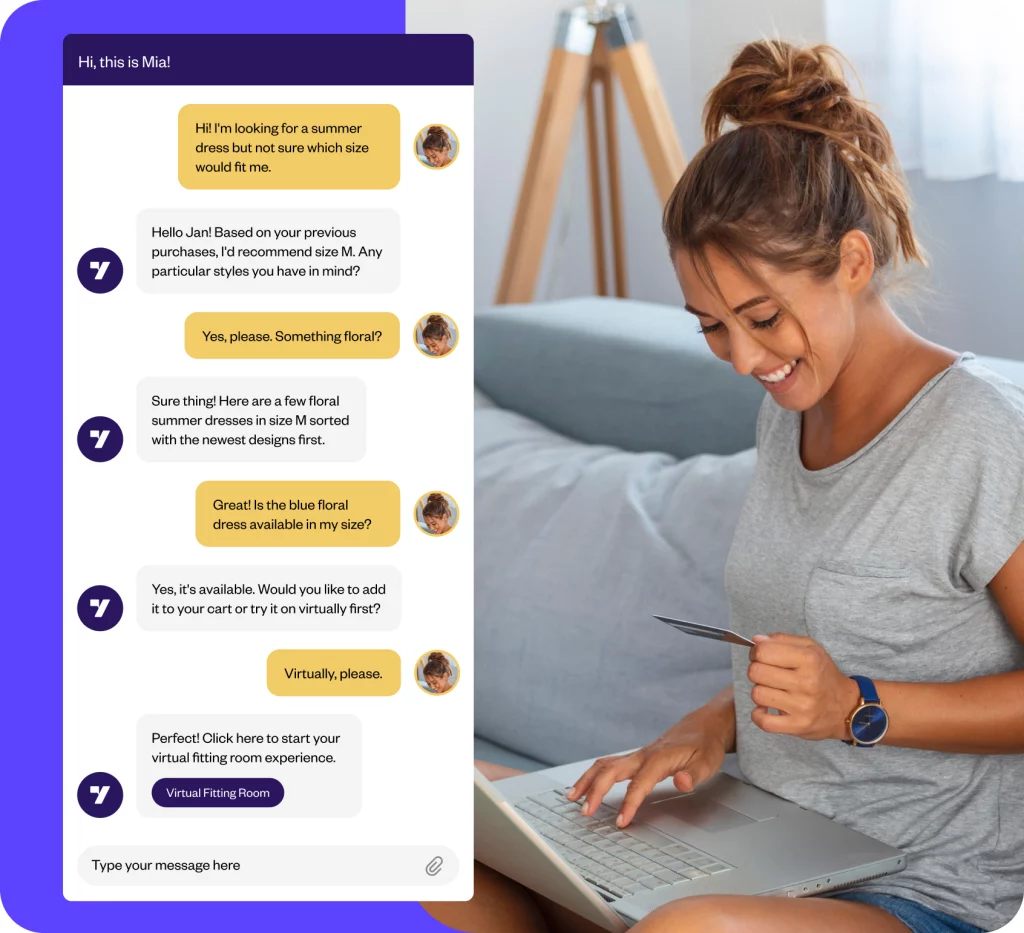
Why are ecommerce chatbots important?
Ecommerce chatbots have swiftly transitioned from a novel tech feature to a pivotal asset in the online retail world. Their impact in today’s digital market is profound, serving as indispensable tools for businesses aiming to excel in customer engagement and service. Let’s understand why ecommerce chatbots are essential for modern ecommerce businesses:
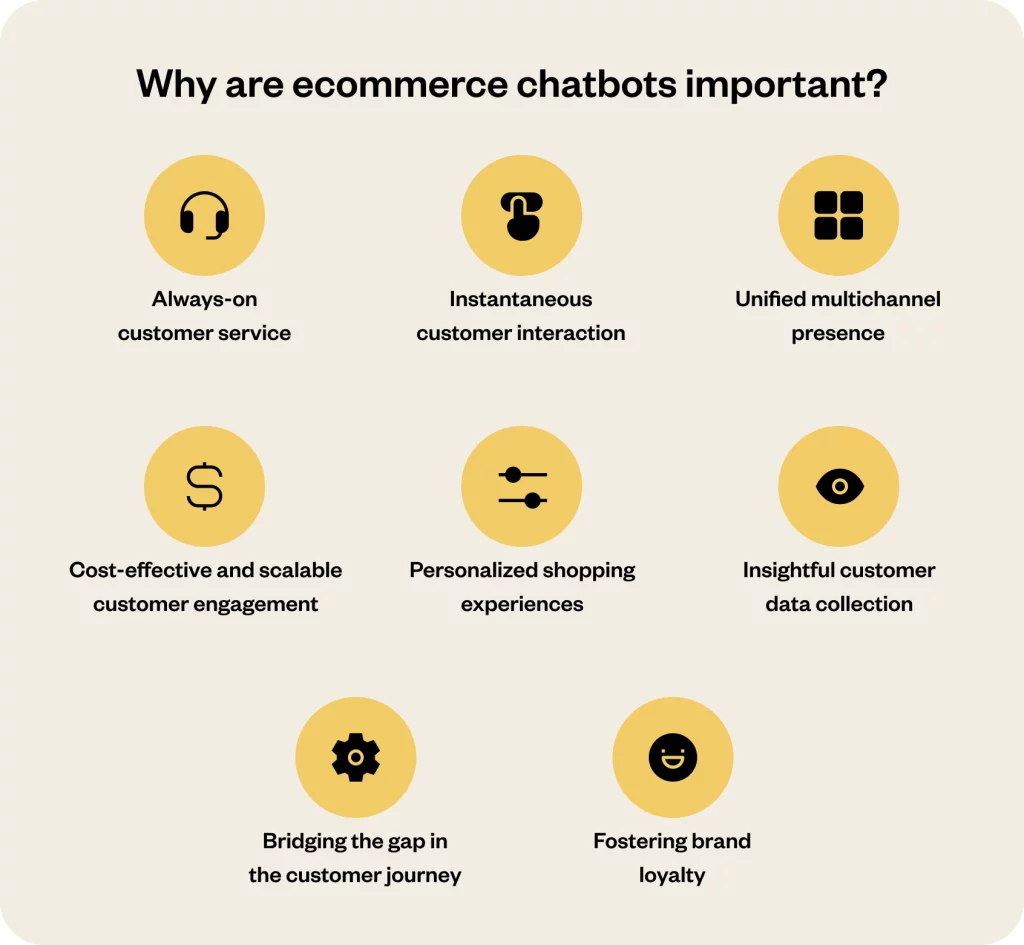
1. Always-on customer service
The digital marketplace never sleeps, and neither do ecommerce chatbots. They stand as vigilant sentinels, providing continuous customer support. This relentless assistance caters to late-night browsers, early risers, and international shoppers alike, ensuring every query is met with an immediate response.
2. Instantaneous customer interaction
In our fast-paced digital era, patience is a scarce commodity. Ecommerce chatbots address this by offering instant solutions to customer inquiries, thereby retaining customer interest and significantly reducing the risk of cart abandonment.
3. Unified multichannel presence
As shoppers flit across various digital platforms, ecommerce chatbots ensure your business does, too. Whether it’s engaging a customer on your website or answering a query on social media, these chatbots deliver consistent service across all channels, weaving a seamless brand experience.
4. Cost-effective and scalable customer engagement
The economic savvy of chatbots is undeniable. They offer a scalable solution to customer service – one that grows with your business, handling multiple interactions simultaneously and reducing the need for a large customer support team.
5. Personalized shopping experiences
Beyond answering queries, ecommerce chatbots take on the role of personal shopping assistants. They use customer data to offer tailored product recommendations and guide shoppers through their buying journey, making each interaction feel special and understood.
Related read: Customer experience in retail: Strategies and the future of CX
6. Insightful customer data collection
These AI-powered assistants double as data gatherers, collecting invaluable customer insights. This treasure trove of information enables businesses to fine-tune their strategies, ensuring they are always aligned with customer preferences and behaviors.
7. Bridging the gap in the customer journey
Chatbots act as bridges over potential gaps in the customer journey. By promptly addressing concerns and questions, they smoothen the path to purchase, helping turn browsing into buying.
8. Fostering brand loyalty
Ecommerce chatbots provide consistent, personalized, and efficient service, which goes a long way in building customer loyalty. A positive interaction with a chatbot can leave a lasting impression, turning casual visitors into loyal customers.
What are the different types of chatbots?
Ecommerce chatbots have become integral to digital customer service, yet not all chatbots are created equal. Their variety mirrors the diverse needs of online businesses and customers. Let’s explore the different types of ecommerce chatbots and how they cater to various business requirements:
1. Rule-based chatbots
These are the foundational chatbots, often referred to as script-based. They operate on predefined rules and a decision-tree logic. These chatbots are excellent for straightforward tasks and FAQs. Imagine a chatbot on a boutique’s website, guiding a customer through a standard size guide or return policy based on specific inputs. While they excel in consistency, their inability to understand complex queries limits their scope.
Example: A customer looking to track an order on an ecommerce website can interact with a rule-based chatbot. The chatbot, following a set script, asks for the order number and provides real-time tracking information.
2. AI-powered chatbots
These chatbots leverage artificial intelligence, particularly natural language processing (NLP), to understand and respond to user queries in a more human-like manner. They learn from past interactions to improve future responses. Imagine a chatbot that not only answers queries about a product but also suggests alternative products based on the customer’s browsing history and preferences.
Example: A customer who inquires about vegan skincare products on an ecommerce site is greeted by an AI chatbot. The chatbot not only provides product recommendations but also offers additional information such as ingredients, usage instructions, and customer reviews.
3. Hybrid chatbots
Hybrid chatbots combine the best of both worlds: rule-based scripting for basic queries and AI for more complex interactions. It ensures efficiency and scalability while maintaining a level of personalization and understanding in conversations.
Example: A customer on an electronic store’s website asks a hybrid chatbot about the best smartphone within a specific budget. The chatbot uses its rule-based system to identify phones in the given price range. Then, it applies AI to recommend a phone based on the customer’s previous inquiries or purchase history.
4. Transactional chatbots
Focused on facilitating transactions, these chatbots streamline the buying process. From adding items to the cart to guiding through the checkout process, they’re like virtual cashiers.
Example: A customer wants to purchase a laptop. The transactional chatbot assists in selecting a model, adding accessories, applying discounts, and navigating through the payment process.
5. Customer support chatbots
Designed primarily for post-purchase support, these chatbots handle inquiries related to order status, returns, and product troubleshooting, enhancing the post-purchase customer experience.
Related read: Customer service chatbots: Benefits and examples [2023]
Example: A customer who needs help setting up a newly purchased smart home device gets step-by-step guidance from the chatbot, ensuring a smooth product setup experience.
6. Voice-enabled chatbots
These chatbots leverage voice recognition technology to provide a hands-free shopping experience, ideal for mobile users or smart home device integrations.
Related read: What are voice bots and their use-cases for different industries?
Example: A user can verbally ask a voice-enabled chatbot on their smart speaker about the latest deals on groceries, and the chatbot responds with the available offers and helps add items to their cart.
Why does your business need an ecommerce chatbot?
Ecommerce chatbots are transforming the way businesses interact with customers. From increasing sales to providing unrivaled customer support, these intelligent assistants are revolutionizing the shopping experience. Let’s delve into the significant benefits these digital assistants bring to your ecommerce business:
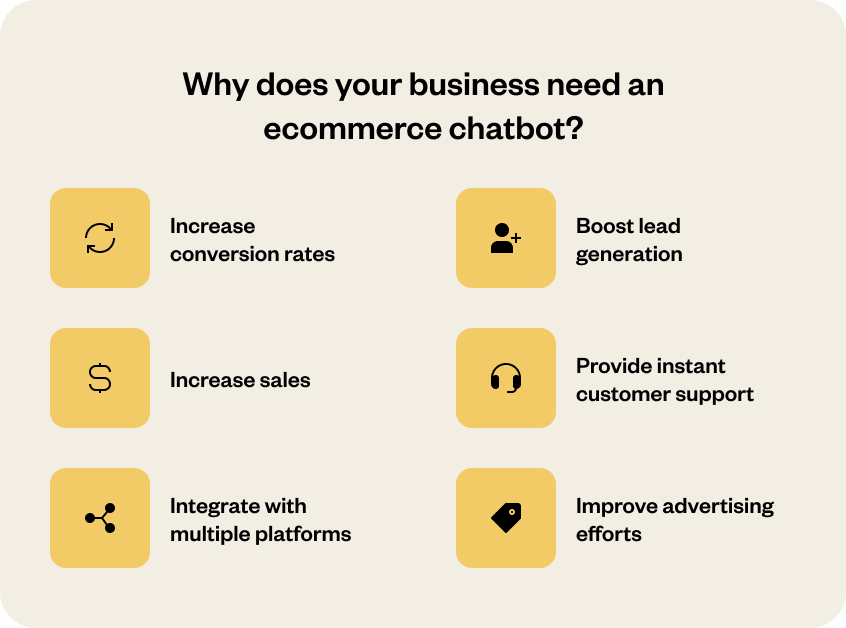
1. Increase conversion rates
Chatbots are a powerful tool for nudging customers along the sales funnel. By providing timely assistance and answering queries at crucial decision-making moments, they reduce customer hesitation and indecision. Imagine a chatbot that gently guides a customer through product comparisons or offers additional information at the checkout, effectively decreasing cart abandonment and enhancing conversion rates.
Increase conversions by 50% with personalized conversations on your Shopify store.

2. Boost lead generation
Ecommerce chatbots are adept at qualifying leads through interactive conversations. They engage visitors with personalized greetings and questions, gather contact details, and segment leads based on responses. This targeted approach not only generates high-quality leads but also lays the groundwork for tailored marketing strategies.
3. Increase sales
Chatbots are sales drivers equipped to upsell and cross-sell with impeccable timing. For example, a chatbot might suggest complementary accessories when a customer is viewing a dress or offer a premium version of a product the customer is interested in. By intelligently recommending products, chatbots increase the average order value and overall sales.
4. Provide instant customer support
The immediate response provided by chatbots is a game-changer in customer service. They are available around the clock, answering FAQs, resolving issues, and providing support during and after business hours. This 24/7 service ensures customer queries are addressed promptly, improving customer satisfaction and loyalty.
5. Integrate with multiple platforms
Ecommerce chatbots offer versatility in integration. They can be synced with various ecommerce platforms, social media channels, and messaging apps, providing a consistent customer experience across different touchpoints. This integration enables businesses to reach customers where they are, be it on a website, Facebook, Instagram, or WhatsApp.
6. Improve advertising efforts
Chatbots can revolutionize your advertising campaigns. By integrating chatbots with social media ads, businesses can engage customers directly in Messenger, providing immediate interaction and personalized product recommendations. This direct engagement increases the likelihood of conversion, making your advertising efforts more effective.
3 Examples of ecommerce chatbots
The digital world of ecommerce is buzzing with a new kind of energy, thanks to chatbots. These aren’t just lines of code; they’re like the friendly, knowledgeable shop assistants who know just what you need. Let’s take a walk through some real-life stories where chatbots have not just made shopping easier but also added a touch of human warmth to the online world:
1. A leading French multinational retailer of personal care and beauty products: Virtual consultant enhancing shopping
- Challenge: The brand, renowned for its personalized in-store experience, sought to replicate this level of engagement online.
- Solution: Implementing a virtual assistant, this beauty and personal care products brand now offers personalized beauty consultations and streamlined online shopping.
- Outcome: This approach has not only elevated the online customer experience but also strengthened the brand as a digital innovator in beauty retail.

2. A coveted fashion label from Southeast Asia: Fashion forward with chatbots
- Challenge: As a leading fashion destination in Southeast Asia, it aimed to enhance support operations without overburdening its workforce.
- Solution: The introduction of ecommerce chatbots enabled automated, delightful shopping experiences, leading to increased customer satisfaction.
- Outcome: The brand expanded globally with multilingual support, saving significant manpower hours while maintaining exceptional customer service.

3. A prominent Indonesian supply chain platform: Streamlining farm-to-fork operations
- Challenge: Dealing with high customer inquiry volumes and limited agent availability.
- Solution: An all-encompassing chatbot solution on WhatsApp and web platforms for handling orders and customer queries.
- Outcome: The esteemed brand efficiently managed large volumes of customer interactions, enhancing query resolution and order management.

These examples showcase the versatility and efficacy of ecommerce chatbots across various sectors. They demonstrate their capability to adapt to different business models and customer needs. Besides enhancing the shopping experience, they also significantly contribute to operational efficiency and customer satisfaction.
How to use a chatbot for an ecommerce website?
Implementing a chatbot on your ecommerce website is a strategic move that can significantly enhance customer interaction and operational efficiency. By following some simple steps, you can ensure a smooth integration of this technology, making your ecommerce platform more responsive, personal, and customer-friendly. Remember, the goal is not just to implement a chatbot but to create a more engaging, efficient, and enjoyable shopping experience for your customers.
For businesses looking to leverage this technology, here’s a comprehensive guide on integrating chatbots into an ecommerce website effectively:
Step 1: Identifying business and customer needs
Assessment and goals: Start by evaluating your business requirements. Are you looking to streamline customer support, enhance sales, or provide personalized shopping experiences? Pinpoint the key areas where a chatbot can add value.
Customer insights: Understand your audience’s needs. What are the common queries or pain points of your customers? Gathering this data will help tailor your chatbot to address these specific issues effectively.
Step 2: Choosing the right chatbot type
Rule-based vs. AI-powered: Decide between a simple rule-based chatbot for basic inquiries or an AI-driven chatbot for a more dynamic interaction. Consider the complexity of customer queries and the level of personalization you aim to achieve.
Compatibility check: Ensure the chatbot you choose integrates seamlessly with your existing ecommerce platform and other digital tools.
Soar your ecommerce reach and sales with simple one-click integrations.

Step 3: Customizing the chatbot experience
Personal touch: Customize the chatbot’s language and responses to align with your brand voice. It will help create a consistent brand experience across all customer touchpoints.
User journey mapping: With traditional bots, you’d need to design the chatbot flow based on typical customer journeys. Identify key interaction points where the chatbot can assist, such as product recommendations or checkout assistance. But with today’s powerful AI chatbots like the ones from Yellow.ai, all you need to do is define the lifecycle stages of your customers and the goal you want to achieve, and voila, let the chatbot take care of the rest!
Go to market 3x faster with Yellow.ai’s AI-powered user lifecycle optimizer.

Step 4: Integration and testing
Seamless integration: Install the chatbot on your ecommerce website. This process might involve adding a code snippet to your site or using integration tools provided by your ecommerce platform.
Testing and feedback: Before going live, the chatbot should be rigorously tested with different scenarios and user queries. Feedback should be collected and adjustments made to ensure it operates flawlessly.
Step 5: Monitoring and analytics
Performance tracking: Utilize chatbot analytics to monitor interactions and customer engagement. Pay attention to metrics like response time, query resolution rate, and user satisfaction.
Continuous improvement: Regularly update the chatbot based on customer feedback and changing business needs. It ensures the chatbot remains relevant and effective in enhancing the customer shopping experience.
7 Ecommerce chatbot use cases
Ecommerce chatbots are much more than automated responders. They’re like the attentive store associate who remembers your name and preferences, the problem-solver who helps you track your order, and the friendly advisor who knows precisely what you need.
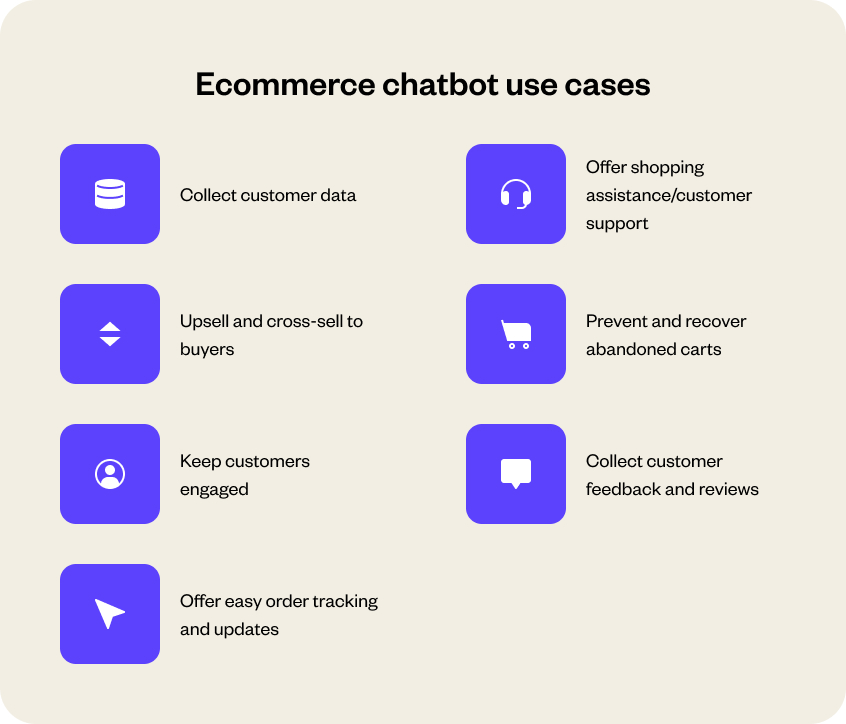
Let’s explore their various use cases, showcasing how they bring efficiency, personalization, and innovation to online businesses.
1. Collect customer data
Ecommerce chatbots excel at subtly collecting customer preferences and behavior data during interactions. This data is a goldmine, crucial for tailoring marketing strategies and understanding consumer trends.
Consider a chatbot on a clothing store’s website. It engages visitors in a casual conversation about style preferences, gathering data that helps suggest personalized fashion picks later.
2. Offer shopping assistance/customer support
Chatbots step in as on-the-spot assistants, offering product recommendations, answering FAQs, and resolving common purchase barriers like questions about sizing or compatibility. Utilizing NLP (Natural Language Processing), chatbots can understand and respond to complex customer queries, providing relevant product information and even troubleshooting issues in real-time.
3. Upsell and cross-sell to buyers
Chatbots are smartly programmed. Hence, they can suggest complementary products or upgrades, enhancing customer experience and increasing average order value. For example, a customer shopping for a camera might be prompted by the chatbot to consider a tripod or an extended warranty, enhancing their purchase and boosting sales.
4. Prevent and recover abandoned carts
Chatbots can detect when a customer is about to abandon their cart and intervene with targeted messages, offers, or assistance to encourage the completion of the purchase.
By analyzing customer interaction data and cart contents, chatbots can personalize messages to address specific concerns or offer compelling reasons to finalize the sale.
5. Keep customers engaged
After the customer makes a purchase, chatbots keep the dialogue going, sending product care tips, updates, and relevant offers to nurture the customer relationship. For example, after purchasing a coffee machine, customers receive chatbot messages offering cleaning tips, special coffee bean offers, and maintenance check reminders.
6. Collect customer feedback and reviews
Chatbots proactively seek customer feedback and product reviews, providing businesses with critical insights for improvement and customers with a voice to be heard. With sentiment analysis capabilities, chatbots can gauge customer satisfaction and flag negative experiences for immediate follow-up, turning potential detractors into promoters.
7. Offer easy order tracking and updates
Ecommerce chatbots offer real-time updates on order status and delivery tracking. It can assist in modifying order details, which enhances the post-purchase customer experience. Integrating with logistics APIs, chatbots provide accurate, up-to-the-minute information about a customer’s order, from warehouse dispatch to doorstep delivery.
Where can you use ecommerce chatbots?
Ecommerce chatbots are not just confined to a single corner of your digital storefront; they’re like versatile players in the world of online retail, capable of enhancing customer experience across various platforms.
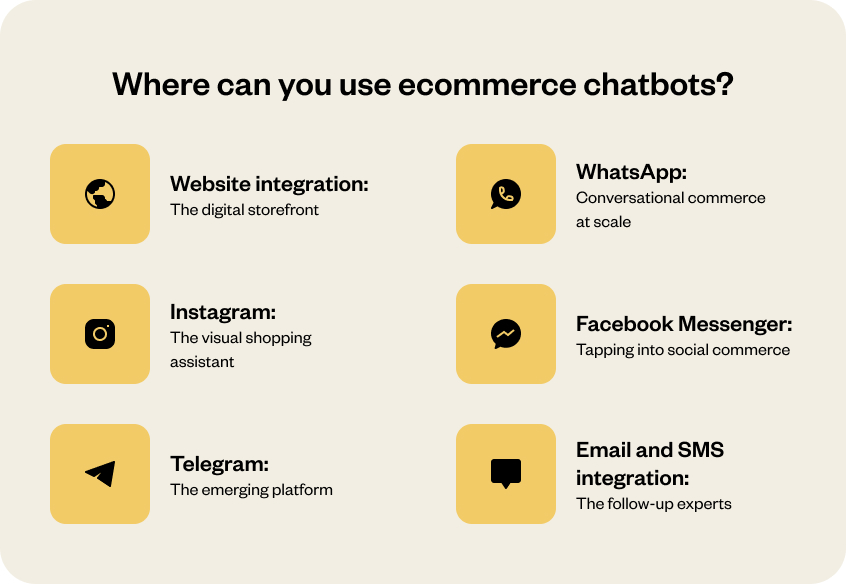
Let’s explore where these digital assistants can be strategically placed to maximize their potential.
1. Website integration: The digital storefront
Embedding chatbots on your ecommerce website is like placing a knowledgeable salesperson on the shop floor. They greet visitors, offer guidance, and assist in navigating through your site, elevating the shopping experience. These chatbots can significantly reduce cart abandonment rates by engaging customers at critical decision points, answering queries, and offering instant support, thereby boosting customer satisfaction and sales.
2. WhatsApp: Conversational commerce at scale
With its vast user base, WhatsApp is a goldmine for ecommerce businesses. Chatbots on this platform can handle customer queries, update order statuses, and promote products, all through a familiar chat interface. These chatbots can streamline communication, offer real-time customer support, and enhance marketing efforts, making WhatsApp an indispensable tool for customer engagement and retention.
3. Instagram: The visual shopping assistant
As your business flourishes on Instagram, managing Direct Messages (DMs) can become overwhelming. Chatbots here act as efficient assistants, handling inquiries and keeping conversations flowing. They can automate responses to common queries, provide product information, and even direct customers to your website, making Instagram a viable channel for customer engagement and sales.
4. Facebook Messenger: Tapping into social commerce
Integrating chatbots with Facebook Messenger opens doors to a vast audience. These chatbots interact with potential customers who discover your brand through Facebook, offering them personalized shopping experiences. They can guide users from discovery to purchase, share promotions, and redirect them to your website, effectively increasing your reach and engagement on one of the world’s largest social media platforms.
5. Telegram: The emerging platform
Telegram, though less popular than WhatsApp, is gaining traction as a marketing and customer support tool. Chatbots on Telegram can provide a similar range of services, from answering queries to promoting new arrivals. Their use in Telegram allows businesses to cater to a niche but growing audience, offering personalized customer service and marketing outreach.
6. Email and SMS integration: The follow-up experts
Chatbots aren’t limited to real-time interactions. They can be programmed to follow up with customers via email or SMS, providing updates, seeking feedback, or even re-engaging dormant customers. This continued engagement fosters a sense of brand loyalty and keeps your business at the forefront of customers’ minds, encouraging repeat visits and purchases.
7 Things to keep in mind while building an ecommerce chatbot
Ecommerce chatbots are reshaping the way online businesses interact with customers. However, creating an effective chatbot requires more than programming skills; it requires a deep understanding of customer needs and preferences. Here’s a roadmap to guide you through the essential elements to consider when building an ecommerce chatbot.
1. Understanding customer needs
Start by delving into your customers’ journey. Analyze interactions, queries, and feedback to identify common pain points and expectations. This understanding will be crucial in determining the primary functions and capabilities of your chatbot. Tailoring your chatbot to address specific customer needs ensures a more relevant and efficient user experience, increasing the likelihood of successful interactions and conversions.
2. Crafting natural conversational flows
Design your chatbot’s conversation flow to mimic human-like interactions. Consider the natural progression of a customer’s inquiry and how the chatbot should respond to provide helpful and coherent dialogues. A chatbot with a smooth conversational flow can significantly enhance the customer experience, making interactions more enjoyable and effective. It can lead to higher engagement rates. The good news is, with the advancements in generative AI-powered platforms like Yellow.ai, this has become extremely easy and quick, where the platform does most of the heavy lifting with basic inputs from you.
3. Seamless data integration
Integrate your chatbot with key internal systems like CRM, ERP, and other relevant databases. This integration allows the chatbot to access and utilize customer data in real-time, enabling personalized and informed responses. Real-time data access empowers the chatbot to provide accurate, context-aware assistance, elevating the customer’s shopping experience and fostering trust in your brand.
4. Continuous learning and adaptation
Employ deep reinforcement learning to enable your chatbot to learn from past interactions. This approach helps the chatbot to continuously improve its responses and adapt to new queries over time. A self-learning chatbot can handle a more comprehensive array of inquiries more effectively, reducing the likelihood of unresolved questions and enhancing overall customer satisfaction.
5. Infusing personality into the chatbot
Give your chatbot a distinct personality. It includes a name, tone of voice, and style of interaction that aligns with your brand identity. A chatbot with a relatable personality can create a more engaging and memorable experience for customers, fostering a stronger emotional connection with your brand.
6. Rigorous testing and optimization
Extensively test your chatbot to ensure it responds accurately and effectively to various queries. Pay attention to conversational flow, response accuracy, navigation, and error management. Testing helps identify and rectify any issues before launch, ensuring a smooth and reliable customer experience. It also helps in fine-tuning the chatbot for optimal performance.
7. Strategic deployment across platforms for a seamless omnichannel experience
Launch your chatbot on platforms where your customers are most active – be it your website, social media, messaging apps, SMS, or email. An omnichannel chatbot ensures that customers can receive consistent and convenient support regardless of the platform they choose, enhancing the accessibility and reach of your business.
Why choose the Yellow.ai chatbot platform as your ecommerce chatbot?
Yellow.ai stands out as a premier chatbot platform for ecommerce businesses. Our AI-driven solutions are designed to enrich customer interactions and boost business efficiency. Here’s why Yellow.ai is the smart choice:
- Advanced AI and Generative AI capabilities: Yellow.ai chatbots use sophisticated AI, generative AI, and specialized LLMs trained on 12+ billion conversations every year to offer highly personalized and human-like customer experiences.
- Seamless system integration: Effortlessly integrate with your existing ecommerce systems for a smooth operational flow, enhancing efficiency without disrupting current processes.
- 24/7 customer engagement: Our chatbots are always available, ensuring your customers receive prompt and accurate responses anytime, enhancing satisfaction and engagement.
- Multilingual support: With support for over 135 languages and dialects, your business will be accessible and inclusive to diverse customer groups.
- Data-driven insights: Utilize actionable analytics to track chatbot performance and optimize your strategies for better customer engagement and business growth.
- Scalable solutions: As your business expands, our chatbots scale with you, efficiently managing increasing customer interactions and adapting to evolving needs.

Conclusion: Charting a new course in ecommerce
Chatbots represent a harmonious blend of technology and customer service, offering businesses an invaluable tool to engage, understand, and satisfy their customers like never before. By embracing this innovative technology, businesses can look forward to a future where customer interaction is not only efficient but also delightfully personalized. The era of AI-driven ecommerce is here, and it promises a shopping experience that is more intuitive, engaging, and rewarding for both businesses and consumers alike.
Frequently asked questions (FAQs)
What is a chatbot in ecommerce?
In ecommerce, a chatbot is an AI-driven software designed to simulate human-like conversations with customers. It assists in various online shopping processes, such as answering queries, providing product recommendations, facilitating transactions, and offering customer support, thereby enhancing the overall digital shopping experience.
How do I create a chatbot for my ecommerce website?
Creating a chatbot for an ecommerce website involves several steps: identifying the specific needs of your business, selecting the appropriate type of chatbot (rule-based or AI-powered), customizing it to match your brand voice, integrating it seamlessly with your website and other digital tools, and continuously monitoring and improving its performance based on customer interactions.
What is an example of an AI chatbot in ecommerce?
An example of an AI chatbot in ecommerce is a virtual shopping assistant on a fashion retailer’s website. This chatbot can provide personalized style recommendations, answer queries about product sizes and availability, assist in the checkout process, and even offer post-purchase support like order tracking and returns handling.
Why is a chatbot important in ecommerce?
Chatbots are essential in ecommerce because they provide instant, round-the-clock customer service, improve the efficiency of customer interactions, personalize the shopping experience, assist in lead generation and sales, and gather valuable customer insights. They help businesses meet modern consumers’ growing expectations for quick, convenient, and personalized online shopping experiences.
How does an ecommerce chatbot improve a website?
An ecommerce chatbot improves a website by enhancing customer engagement and satisfaction through immediate response to queries, personalized product recommendations, and seamless assistance throughout the shopping journey. It also reduces the workload on customer service teams and gathers insights for better business decisions.
Why is AI the future of ecommerce?
AI is the future of ecommerce because it enables businesses to automate and personalize customer interactions, gain deep insights into consumer behavior, predict trends, and make data-driven decisions. AI technologies, like chatbots, are transforming ecommerce into a more efficient, customer-centric, and adaptive industry, keeping businesses ahead in a rapidly evolving digital marketplace.






















